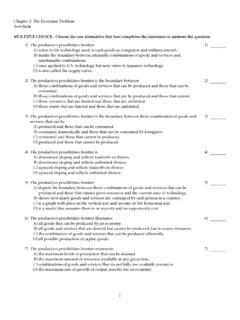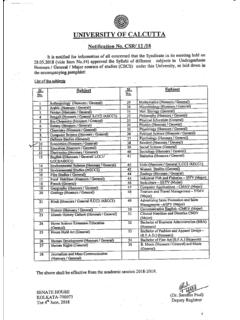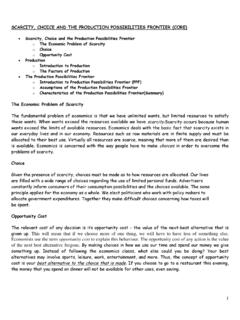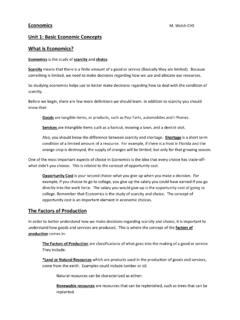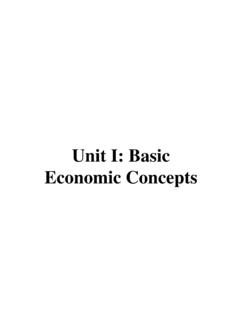Transcription of Economics 101 – Principles of Economics
1 On-line Econ 101: what you need to know before you enroll It is critical for you to complete assignments, quizzes and tests on time. The material builds on itself throughout the course (and becomes more challenging). Take this course only if you will have the time and energy to devote regular weekly attention to it. I do not grant ETs in this course and the deadline for completing all work is in late April. You ll need to dust off your algebra skills. Nothing too tricky, but you ll have to calculate the slope of a line and solve two equations for two unknown variables. Many of the assigned problems can be solved with simple arithmetic but they require you to apply your understanding of the theory to new situations.
2 Economics 101 Principles of Microeconomics Spring 2016 Dr. Amy McCormick Diduch Contact information: Office phone: 540-887-7114 Fax machine: 540-887-7040 Office location: Carpenter Academic 309 Mary Baldwin College, Staunton, VA 24401 About this course: Economics is the study of scarcity and choice in response to incentives. In this course, students learn how economists analyze choices made by individuals, businesses and governments and how those choices determine the prices and quantities of goods and services, the types of goods and services offered for sale, the structure and level of competition faced by businesses, and the limits placed on private market transactions by government decisions.
3 Learning outcomes: Economics 101 satisfies a requirement in the Common Curriculum for Learning Outcome 1a: Social Sciences because it introduces students to the theories commonly used in economic analysis, including the concepts of supply and demand, marginal analysis, elasticity, and market structure. Students learn the basic tools of economic analysis, including mathematical equations, graphs, and logical reasoning. For this reason, Econ 101 also satisfies a Common Curriculum requirement for Learning Outcome 3a: Quantitative Reasoning. Successful completion of Econ 101 serves as a prerequisite for many other Economics courses, including Econ 102: Principles of International and Macroeconomics.
4 Text: We are now using a free Internet-based textbook (although you can order a print version at low cost). You can use the book in whichever format(s) you want; I recommend that you download the entire .pdf so that you always have access to your book. Principles of Microeconomics by Timothy Taylor et al, from OpenStax College, ISBN1-938168-24-0, Pros of using this text: It s free and it s easy to access. Cons of using this text: it doesn t quite cover all of the course material or sometimes covers it in a way that significantly differs from how we do it here at MBC. As a result, you will often be assigned readings from other web sites or from articles posted on Blackboard.
5 As an alternative, you can purchase a used edition of Economics by David Colander (Ninth edition, McGraw-Hill 2012, ISBN: 978-0078021701). I think Colander is an excellent writer who explains concepts clearly. However, his textbook even used is expensive. Buy this if you want the Cadillac version of a Principles of econ text! How this course works: Each topic in this course is taught through a series of brief videos created by Dr. Diduch (and posted on Blackboard) and, for some topics, written tutorials (which present practice problems). After viewing a set of videos for topic and reading the textbook, students work through and submit problem sets to Dr.
6 Diduch for grading and feedback. After reviewing the problem set answers, students take a quiz on that section s material. Two midterm exams and the final cover larger blocks of material (and the final exam is cumulative). Exams are usually open notes, open book (but aren t easy)! To submit a problem set, you will either upload it to Blackboard or e-mail it to me. All problem sets require you to sketch graphs. Most students prefer to sketch these by hand (and I usually find the results are better when students do this). This means that students need access to a scanner OR must be able to photograph their hand-drawn graphs and place the photos into the problem set document.
7 Talk to Dr. Diduch if you are unsure about this requirement. An alternative: you may use a drawing program such as Google Draw to sketch your graphs. This will work best if you are comfortable using all of the editing options in the drawing program (including text entry, variations in line style, arrows and brackets, etc.). These graphs can be copied and pasted into your work. In an emergency, you can fax your work to me. The fax machine is NOT in my office, so you ll need to tell me any time you send one or I won t know to look for it. Assessment of your work: Problem sets and discussions 10% Quizzes 15% Test 1 25% Test 2 25% Cumulative Final 25% Grade scale: 90-100 A range, 80-89 B range, 70-79 C range, 60-69 D range, below 60, F (with pluses and minuses assigned according to MBC grade cutoffs).
8 Problem sets: Assignments will be posted on Blackboard. Problem sets are organized by topic and due date. In general, late problem sets will be penalized a minimum of one letter grade (and more if they are very late). The only exceptions will be for students who usually submit work on time but hit an unexpected event that requires a delay. Please contact me if this happens to you. Problem sets are graded partly for correctness but mostly for completeness and effort. 0 = not turned in; 1-5 points for incomplete answers or low level of effort on answers ( only providing a few words to answer a discussion question); 6-8 points for a complete set of answers displaying reasonable effort but containing multiple incorrect answer; 9-10 points for complete set of answers that are mostly correct.
9 Discussions will take place on Blackboard. Once announced, students will have approximately two weeks to respond to discussion questions. Students are expected to post their own ideas and respond to the ideas of other students. There will be two or three discussions during the term. Quizzes Quizzes will be taken on Blackboard and will follow the completion of each unit of study. I will drop the lowest quiz grade. How to succeed in Economics : Use ALL the resources available to you! Watch the lecture videos and take notes. Read the textbook. Use extra materials such as the tutorials or handouts posted on Blackboard.
10 Ask questions about anything you don t understand. Be an active learner. Work lots of problems! Much of the course-work in Economics revolves around problem solving so you truly can't learn Economics just by reading the textbook. Quizzes and exams are open book, open notes. This does not mean they are easy! You have to understand the material in depth to be able to confidently answer quiz and exam questions. Practice, practice, practice by using the written tutorials, the questions in your book, and sample exams. When you get a problem wrong, re-work it from scratch. Course Outline Unit 1: scarcity and production possibilities Read: o Textbook, Chapter 1: Welcome to Economics o Textbook, Chapter 2 sections 1 4 o From article on the PPF: o From AmosWeb growth and the PPF: Watch the production possibilities lecture videos.
